Contents
Market Overview
Macro Review
A quiet, short, month-end week nestled between U.S. and UK public holidays in which global markets generally lacked firm direction. In that context, news flow out of Asia dominated with Shanghai declaring that its COVID-19 outbreak has been curbed ‘effectively’ and China recording fewer than 100 new COVID-19 cases taking center stage. This, combined with PMIs beating low expectations, provided a whiff of optimism in markets that the worst for the Chinese economy might be behind us. In the U.S., President Biden met with Fed Chair Powell to discuss strategies to fight inflation as the Fed is about to commence quantitative tightening (QT) at a monthly pace of $30 bn in Treasuries and $17.5 bn in MBS/Agency debt. On the interest rate front, several Fed speakers during the week signaled that they would be supportive of 50bp hikes at “several meetings”, which poured some cold water on speculations of a potential ‘pause’ in the Fed’s policy tightening cycle in the fall. Meanwhile, the May jobs report released on Friday showed some signs that steam might be coming out of U.S. labor demand, alongside a pickup in supply. For now, lower pressure from a potentially cooling labor market seems unlikely to deviate the Fed from its well-signaled tightening track over the next few meetings but could introduce discussions about stepping down to a 25bps pace later in the year if the pressure continues to decrease. Elsewhere, the EU agreed to embargo seaborne exports of Russian oil to its member states, which should result in banning around 70% of Russian oil exports to the EU immediately and 90% by the end of 2022.
EM Credit Update
Emerging market sovereign credit ended the week down 0.6% with spreads 10bp wider. Outperformers over the week were El Salvador, Sri Lanka, and Mongolia, while Zambia, Ghana, and Ethiopia underperformed.
The Week Ahead
A slew of central bank rate decisions in EM next week, including in Chile, India, Thailand, Poland, Peru and Russia, alongside ECB’s policy meeting on Thursday. We expect the policy tightening bias across EM to continue. Other important data releases that EM investors will be looking for are the May inflation prints, including in Brazil, Chile, Colombia, Mexico, and Thailand. External trade data out of China for May should provide an important indication if the Covid-related restrictions’ adverse impact on exports have started to ease to some degree, which would be a constructive signal in terms of global supply bottlenecks.
Highlights from emerging markets discussed below include: Colombia first-round election received positively by markets despite policy uncertainty; China May PMI data points to a recovery, although remains in contractionary territory; and Pakistan IMF negotiations on program resumption to continue with focus on budget; Moody’s revises OL to negative
Fixed Income
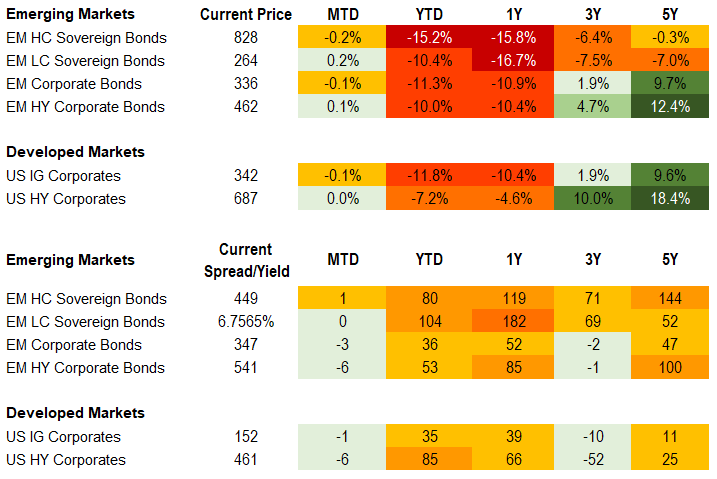
Equities
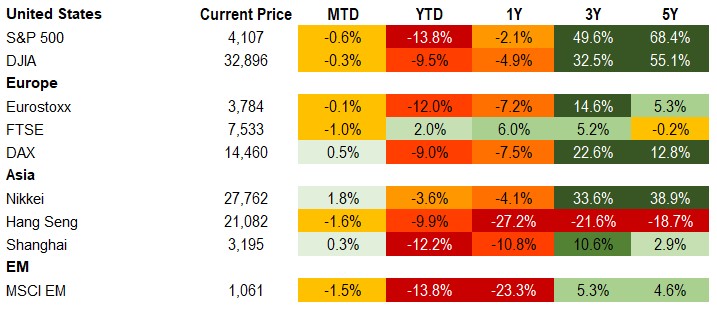
Commodities

Source for data tables: Bloomberg, JPMorgan, Gramercy. EM Fixed Income is represented by the following JPMorgan Indicies: EMBI Global, GBI-EM Global Diversified, CEMBI Broad Diversified and CEMBI Broad High Yield. DM Fixed Income is represented by the JPMorgan JULI Total Return Index and Domestic High Yield Index. Fixed Income, Equity and Commodity data is as of June 3, 2022 (mid-afternoon).
Emerging Markets Weekly Highlights
Colombia first-round election received positively by markets despite policy uncertainty
Event: On Sunday, Colombia held its first round of presidential elections where leftist candidate, Gustavo Petro, garnered the most votes of support with 40%, followed by right-wing independent candidate Rodolfo Hernandez, with 28% of votes. On June 19th, Petro and Hernandez will contend for the presidency in a run-off vote.
Gramercy Commentary: While the outcome is the highest uncertainty scenario from an economic policy perspective in the near-term (putting a leftist populist candidate against a rightest populist candidate with a lack of an economic policy agenda), the initial market reaction has been relatively constructive given that the aggregate support for right leaning candidates Hernandez and Gutierrez of just over 52% exceeded Petro’s 40% of votes. If the majority of Gutierrez votes go to Hernandez, the second round will likely become a narrowed and competitive race. Markets should be well aware of Petro’s policy priorities and if he gets confirmed as Colombia’s next president, investors will look for strong institutions and a centrist Congress to be moderating forces. Conversely, markets know very little at this stage about Hernandez or his policy priorities, especially in regard to economic policy, increasing near-term uncertainty. If Hernandez surrounds himself with a credible economic team, markets will likely react constructively. Conversely, heterodox appointments could pressure assets and the medium-term outlook albeit the scope and duration would depend on the evolution of policy and institutional checks and balances.
China May PMI data points to a recovery, although remains in contractionary territory
Event: The May NBS Composite Index recovered by 5.7pts to 48.4pts, following April’s print which was the lowest level since 2020 on the latest virus surge. Manufacturing and services indices exceeded expectations by 0.6pts and 2.3pts, respectively. While the Caixin manufacturing index missed consensus estimates by 0.9pts at 48.1pts, it rebounded by 2.1pts on the month. New orders, exports, price inputs, and supply time components improved in both manufacturing indices to varying degrees. Employment, which often lags, weakened in the Caixin survey but showed some slight improvement in NBS.
Gramercy commentary: The data is in line with an expected gradual recovery as the current virus wave ebbs, with less than 10% of GDP under lockdown conditions and case levels back near lows. While we expect the authorities to take a cautious approach to reopening, the aforementioned data suggests that the continued improvement will likely push the economy back into expansionary territory for June, assuming no reversal in high-risk jurisdictions and lockdowns in the coming weeks. We believe growth can still be in the 3.5-4.5% range, depending on the development and evolution of policy levers between now and year-end. Given that tourism and outbound travel restrictions will likely still face elevated regulation in the near-term, erosion of the current account surplus should be gradual and CNY pressures dictated largely by capital flows, appear to have stabilized.
Pakistan IMF negotiations on program resumption to continue with focus on budget; Moody’s revises OL to negative
Event: Last week, the IMF published a press release on its recent meetings with the Pakistan authorities regarding a conclusion to the pending seventh review of the existing EFF program. The talks were reportedly constructive with the Fund commending the recent policy rate hikes and agreeing on the need to address elevated inflation, and fiscal and current account deficits. The main sticking point remains fuel and power subsidies, which need to be removed from the FY2023 budget to achieve program objectives. Meanwhile, Moody’s revised its outlook on Pakistan’s B3 rating on heightened external vulnerability and uncertainty regarding their ability to meet external financing needs with the agency noting weak institutions and governance, which increase uncertainty over the future direction of macroeconomic policy and completion of the existing IMF program.
Gramercy commentary: We believe the authorities may be able to deliver a budget sufficient enough to put the program back on track by June 10th as per fuel hikes announced last week albeit with only moderate conviction. While this may allow for the next disbursement, we see greater difficulty in the completion or extension of the program and full release of the remaining $3bn in outstanding funds given the still challenging and fragile political backdrop with a risk of a move toward early elections as the year progresses. On the positive side, May inflation data was not as a high as markets anticipated at 13.6% y/y, but it did continue to rise and will face upward pressure in the backdrop of tariff increases.
Emerging Markets Technicals
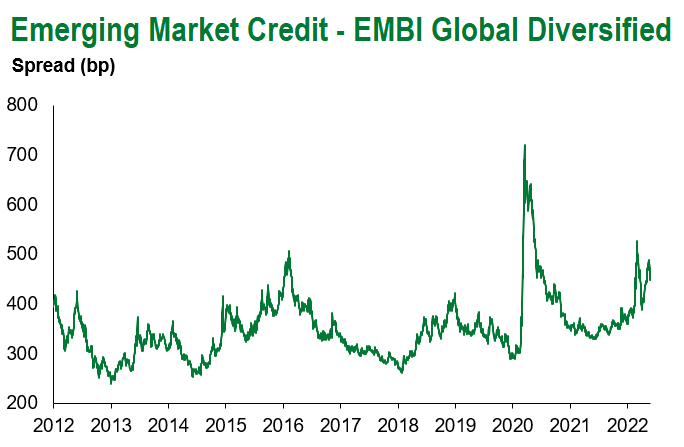
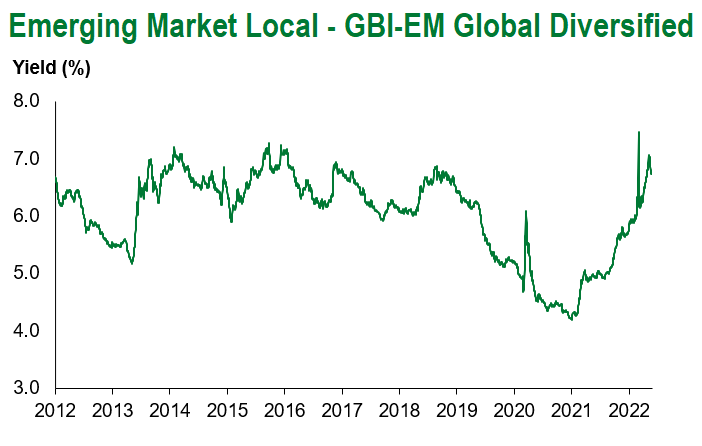
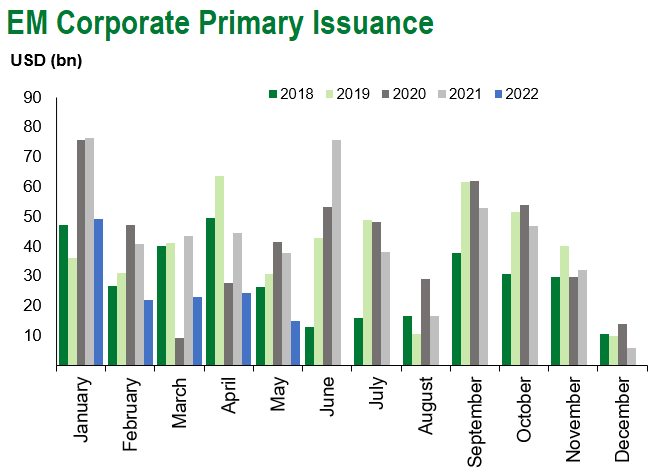
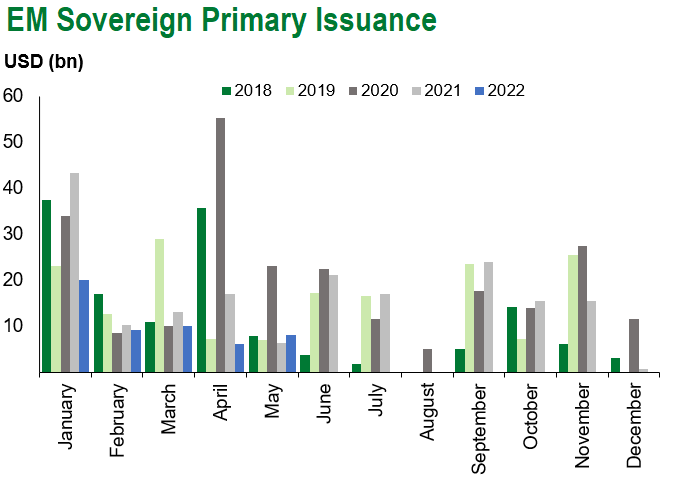
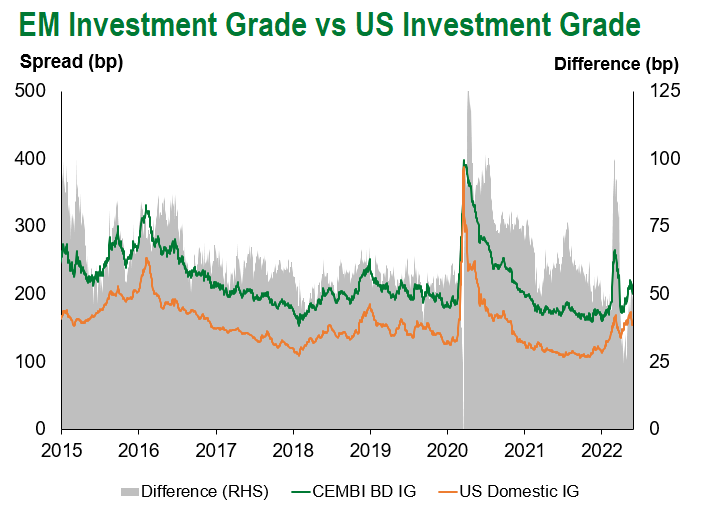
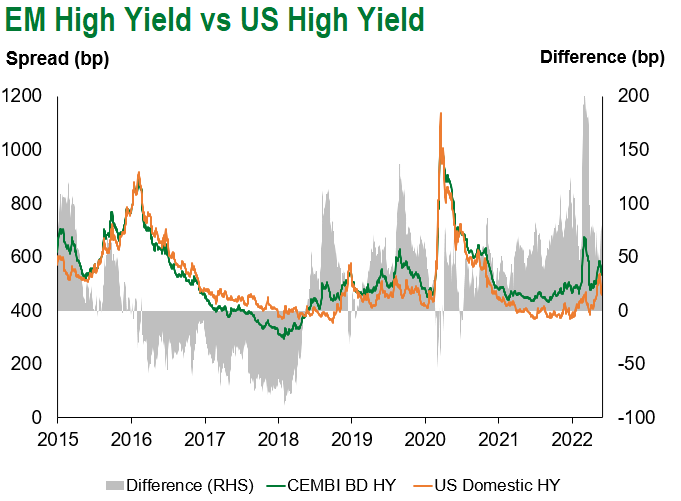
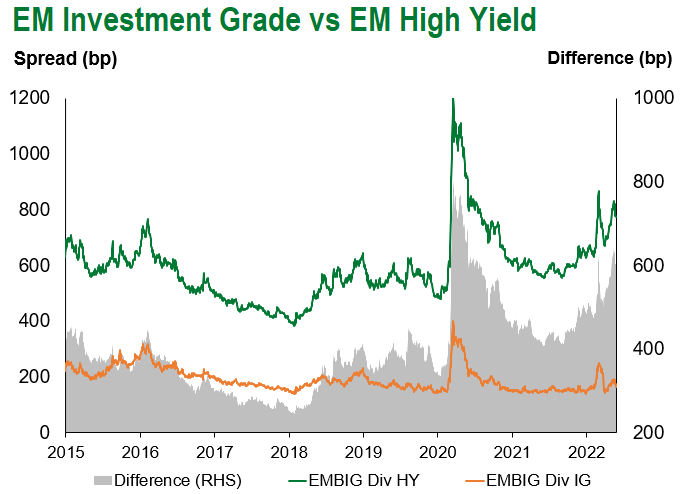
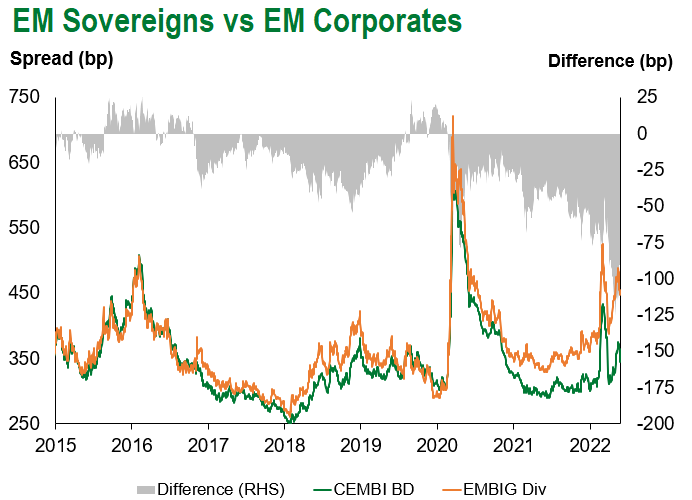
Emerging Markets Flows
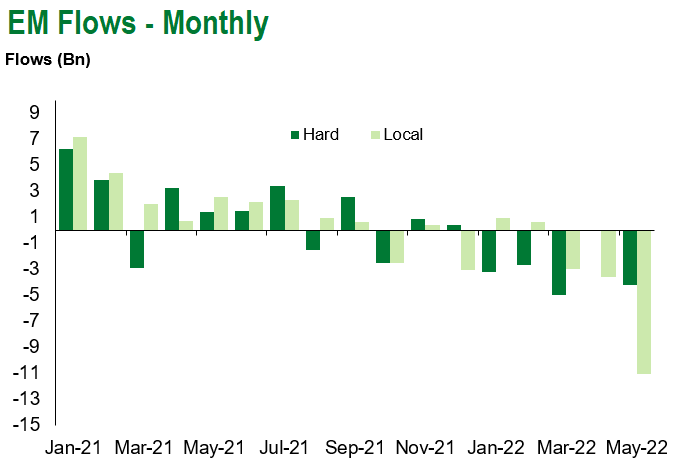
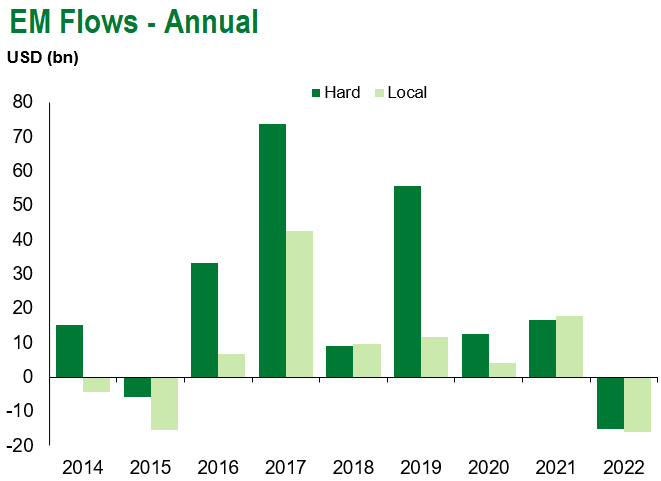
Source for graphs: Bloomberg, JPMorgan, Gramercy. As of June 3, 2022.
COVID Resources:
Johns Hopkins COVID-19 Case Tracker
For questions, please contact:
Kathryn Exum, CFA ESG, Director, Co-Head of Sovereign Research, [email protected]
Petar Atanasov, Director, Co-Head of Sovereign Research, [email protected]
James Barry, Director, Deputy Portfolio Manager, [email protected]
Tolu Alamutu, CFA, Director, Corporate Research Analyst, [email protected]
This document is for informational purposes only. The information presented is not intended to be relied upon as a forecast, research or investment advice, and is not a recommendation, offer or solicitation to buy or sell any securities or to adopt any investment strategy. Gramercy may have current investment positions in the securities or sovereigns mentioned above. The information and opinions contained in this paper are as of the date of initial publication, derived from proprietary and nonproprietary sources deemed by Gramercy to be reliable, are not necessarily all-inclusive and are not guaranteed as to accuracy. This paper may contain “forward-looking” information that is not purely historical in nature. Such information may include, among other things, projections and forecasts. There is no guarantee that any forecasts made will come to pass. Reliance upon information in this paper is at the sole discretion of the reader. You should not rely on this presentation as the basis upon which to make an investment decision. Investment involves risk. There can be no assurance that investment objectives will be achieved. Investors must be prepared to bear the risk of a total loss of their investment. These risks are often heightened for investments in emerging/developing markets or smaller capital markets. International investing involves risks, including risks related to foreign currency, limited liquidity, less government regulation, and the possibility of substantial volatility due to adverse political, economic or other developments. The information provided herein is neither tax nor legal advice. Investors should speak to their tax professional for specific information regarding their tax situation.